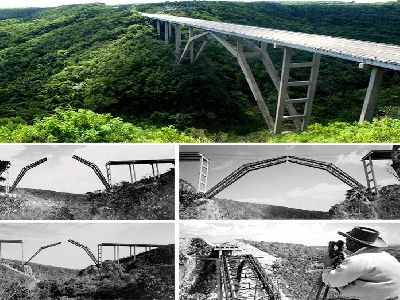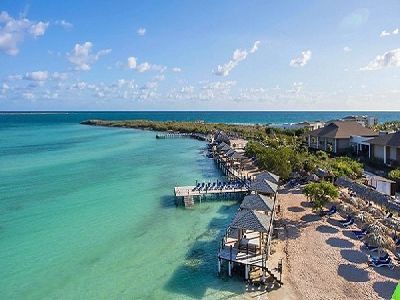Cuban bridge Bacunayagua: 60 years challenging the abyss.

The last link needed to link the Vía Blanca with the province of Matanzas was to design and build a bridge over the Bacunayagua River, which at that time was the boundary between the provinces of Havana (now Mayabeque) and Matanzas, to save a chasm of about 113.5 meters deep to the water level of the river.
With the purpose of encouraging tourism towards the beaches of eastern Havana and Varadero, in Matanzas, the construction of the Vía Blanca began in 1945 to facilitate faster travel to the province of Matanzas.
In 1945 the architect and urban planner Pedro Martínez Inclán, promoted the construction of what is considered the first highway in Cuba, in the Remodeling Plan of Havana or Master Plan, which contemplated several projects.
From the roundabout of the Luminous Fountain, and the Coliseum of the Sports City, the road with six lanes extends eastwards. It crosses between the municipalities of Cerro and October 10 and narrows as it passes through Lacret Street.
It reaches the Agua Dulce square, travels through the north of Luyanó, the industrial zone, south of the port to connect with the central road near the White Horse.
It crosses the access to the National Highway and travels between Regla and Guanabacoa, the Vía Túnel distribution, to Monumental Avenue. At this point, the four-way highway was born, which began to be built in 1954, and that glides along the coast of the north coast with an impressive view of the sea for 98 kilometers to the city of Matanzas. In total, the Vía Blanca is 131.3 kilometers long.
BRIDGE CONSTRUCTION
The Cuban project engineer Luis Sáenz Duplace was responsible for the design of the bridge and its construction to the engineering company Sáenz, Arvesu, Cancio, Martín & Gutiérrez (SACMAG)
Several designs of the bridge were made that would have to be built on an abyss 113.5 meters deep, a challenge for the civil engineering work that had to be carried out, so it was decided to erect it based on the type of semi-arches (Melan system) by It was first executed in Cuba, and it was designed to be used in precast reinforced concrete bridges.
Joseph Melan (1853-1941) was a notable Austrian engineer:
«The Melan construction system, patented in 1892, recognized today as an arch bridge system, was originally a floor construction system, titled in the patent:" Iron arches in combination with concrete vaults ". The Melan system uses, as part of the armor of the vault, beams of steel arches capable of supporting loads, that is, a so-called, rigid armor.
The bridge began to be built at the end of the year 1956 rigorously under the prefabricated technique. The reinforced concrete beams placed along the structural slab, reached a measure of 28 meters in length.
Another important detail is that rolled steel was used for the arches that were built in parallel on both sides of the bridge, and then moved each arch until it reached the correct joint position.
«The construction method used consisted of melting the piles and towers that support the bridge with movable molds. The steel semi-arches that make up the structure, included the formwork to cover them later, while in the beams that join those 47-ton pieces we used pre and post-tensioned systems to give them greater resistance.
These beams were placed by launching armor, because at that time in Cuba there were only cranes of up to 30 tons. The materials used in its construction were the structural concrete for the beams and the rolled steel for the semi-arches, both resistant to climatic attacks, and used for the first time on the Island ».
The first capital repair of the bridge was in 1976, and the last one culminated in mid-March 2015, after three years of intense work by brigades of specialized workers.
The imposing and beautiful bridge of Bacunayagua is considered the seventh wonder of Cuban engineering and the highest in the country. To get a closer idea of its height, we must remember that the Focsa building measures 121 meters, and the bridge 113.5 meters high respectively.
In a tour made by Commander in Chief Fidel Castro through the then province of Havana, he visited the bridge on September 26, 1959 in the company of Celia Sánchez and other colleagues, so that date is taken as the one of its inauguration, although it was not until October 3 that it opened to traffic.
